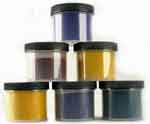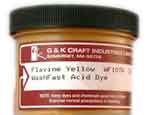Can you recommend a fixative other than Retayne to stop Rit dye on nylon from bleeding?
Can you recommend a fixative other than Retayne to stop Rit dye on nylon from bleeding?
Name: Alex
—ADVERTISEMENTS—

Lanaset Dyes are among the very best dyes for hand-dyeing wool, silk, angora, mohair, and most nylons. You will also need: citric acid, sodium acetate, Glauber salt, Albegal SET, and Synthrapol.
Buy from
Paradise Fibers
Washfast Acid dyes
at Paradise Fibers

Washfast Acid dyes
Also known as Nylomine dyes, excellent for use on nylon. One ounce of dye will dye six pounds of fiber!
at Paradise Fibers

Washfast Acid dyes
Also known as Nylomine dyes, excellent for use on nylon. One ounce of dye will dye six pounds of fiber!

Color for Science, Art and Technology, Volume 1, edited by Kurt Nassau
This technical book explains many features of modern dye chemistry, including the function of syntans as acid dye fixatives.

Country or region: NW USA
Message: I am using Rit Dye to color nylon and I am having trouble to stabilize the dye from bleeding after dying. I tried washing in Retayne, but the color still bleeds afterwards. Some German contacts are recommending Lavegal. Are you familiar with this product? Do you know if this or a comparable product is available in the USA? Thanks for your consideration!!!
I think you'd be much better off choosing a better dye, instead of trying to find a special fixative to improve the washfastness of the poor-quality dye you've been using.
Retayne is a cationic dye fixative, which does help to fix poorly washfast dyes, that is, dyes that tend to bleed when wet. It is designed for use on direct dyes that have been used on cotton and similar fibers. While cationic dye fixatives work by sticking, with their positive charge, to negatively-charged dyes (including acid dyes), there are also acid dye fixatives that work by a different mechanism. For example, one form of acid dye fixative contains synthetic tannins, or syntans, which are negatively-charged compounds with high molecular weights, used to form a surface layer on the fiber, after dyeing, to help seal dye molecules inside the fiber. I have not been able to find much information about Lavegal (most references appear to concern an entirely different product used in galvanizing metal), but, in general, dyeing assistants used to improve the performance of acid dyes on nylon appear to be available in vast quantities suitable only for large-scale industrial use, so it's unlikely you will be able to obtain reasonably small quantities. (Here's a link to the only meaningful information I could find on Lavegal FL.) Anyway, I think it makes more sense for you to concentrate on choosing a better dye.
All-purpose dyes, such as Rit, are known for being exceptionally poorly washfast, which means that they tend to bleed in the laundry or when wet. All-purpose dyes contain a mixture of leveling acid dye, for dyeing wool and nylon, and direct dye, for dyeing plant-based fibers such as cotton. Both of these types of dye are notable for their very low permanence. Leveling acid dye is, in fact, the most poorly washfast form of acid dye. Leveling acid dye is a good choice when you don't care how much the dye bleeds, but when you want a very smooth and even solid color. If you don't want your dye to bleed, you should choose an entirely different sort of acid dye.
A better choice for nylon would be the Washfast Acid dyes, also called Nylomine dyes for their good performance on nylon. Most of the Washfast Acid dyes are acid milling dyes, which are significantly more washfast than leveling acid dyes. The Washfast Acid Jet Black contains a premetallized acid dye; premetallized acid dyes are even more resistant to bleeding the acid milling dyes. The amount of acid required for these dyes is not as great as that required for the acid leveling dyes; acid leveling dyes are also known as "strong acid" dyes, because of the very low pH they require. (Note that dyeing nylon with Rit dye requires heating the dye and the nylon together in the presence of an acid; see my page, About All Purpose Dye, for more details on how much acid to use.)
Another good choice for nylon would be the Lanaset dyes, which includes both premetallized and reactive dyes. These dyes are more expensive per pound, but less dye is needed. They are significantly more washfast than the Washfast Acid dyes, at least on wool; they are so exceptionally washfast that they are tested by washing in hot water at 140°F, unlike other acid dyes whose washfastness is tested by washing in cooler water, at 105°F.
Any other sort of acid dye you can buy will give better performance than acid leveling dyes. Any acid dye you choose will be better than the dyes contained in the all-purpose dye you've been using.
You can buy these superior acid dyes online from several different dye suppliers. In the US, suppliers for Washfast Acid Dyes include PRO Chemical & Dye and Paradise Fibers; suppliers for Lanaset dyes in the US include PRO Chemical & Dye, Paradise Fibers, and Earth Guild. Dharma Trading Company also sells a number of leveling acid dyes, acid milling dyes, and premetallized dyes. Washfast Acid dyes and Lanaset dyes are available in Vancouver from Maiwa Handprints. Avoid the leveling acid dyes, and go for acid milling dyes, premetallized dyes, or Lanaset dyes.
Incidentally, some people assume that all-purpose dye is the cheapest choice, when in fact all-purpose dye is not very economical to use, since each package contains a great deal of salt and detergent, and only a little dye. See my Dye Forum post, "comparison of dye costs". To dye one pound of nylon to a pale to medium with Rit dye requires approximately $2 worth of dye, whereas you can buy enough Washfast Acid dye to dye the same amount of fiber to a medium shade for just 55¢ (plus shipping), assuming you buy two-ounce packages. In the long run, the better performance alone is sufficient reason to stop using all-purpose dyes, but it's nice that we can also save money by doing so.
(Please help support this web site. Thank you.)
(Please help support this web site. Thank you.)
Posted: Wednesday - August 24, 2011 at 02:41 PM
Follow this blog on twitter here.
Quick Links
- All About Dyes & Dyeing Top -
- Top of this blog -
- FAQ -
- The Dye Forum -
- How to Tie Dye - How to Batik -
- Books - Toys - Plants -
- Top of this blog -
- FAQ -
- The Dye Forum -
- How to Tie Dye - How to Batik -
- Books - Toys - Plants -
More in this category:
- -
Statistics
Total entries in this blog:
Total entries in this category:
Published On: Aug 29, 2012 02:49 PM
Total entries in this category:
Published On: Aug 29, 2012 02:49 PM